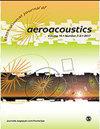Ffowcs-Williams和Hawkins方程的高效频域四极校正
IF 1.3
4区 工程技术
Q3 ACOUSTICS
引用次数: 0
摘要
在本文中,对于具有可渗透控制面的Ffowcs-Williams和Hawkins(FW-H)方程,以计算有效的形式导出了四极校正的频域公式。四极校正有效地减少了与穿过积分表面的流体动力学波动相关的杂散噪声,该噪声最初是为时域中的Farassat公式1A推导的。然而,当寻求相应的频域公式时,会出现困难,因为它的格林函数是以对流形式写成的,与公式1A的格林函数不同。首先,通过对直线运动应用简单的伽利略变换,对流FW-H方程的数学框架被证明等价于公式1A。然后,通过直接应用于时域四极校正形式的傅立叶变换导出频域公式。在涡旋对流和非均匀熵对流的验证研究中,导出的公式的结果与时域解完全一致,其中通过现有的四极校正积分可以有效地去除杂散噪声。本文章由计算机程序翻译,如有差异,请以英文原文为准。
Computationally efficient, frequency-domain quadrupole corrections for the Ffowcs Williams and Hawkings equation
In the present article, frequency-domain formulations of quadrupole corrections are derived in a computationally efficient form for the Ffowcs Williams and Hawkings (FW-H) equation with permeable control surfaces. Quadrupole corrections effectively reduce spurious noise associated with hydrodynamic fluctuations passing across integral surfaces, originally derived for Formulation 1A of Farassat in the time domain. When a corresponding frequency-domain formulation is sought, however, difficulty arises as its Green’s function is written in a convective form and different from that of Formulation 1A. First, the mathematical framework of the convective FW-H equation is shown to be equivalent to Formulation 1A by applying a simple Galilean transformation for rectilinear motion. Then, a frequency-domain formulation is derived via a Fourier transform applied directly to the time-domain quadrupole correction forms. The results of the derived formulation agree precisely with the time-domain solutions, in the verification study of vortex convection, as well as non-uniform entropy convection, in which spurious noise can be effectively removed by the present quadrupole correction integrals.
求助全文
通过发布文献求助,成功后即可免费获取论文全文。
去求助
来源期刊

International Journal of Aeroacoustics
ACOUSTICS-ENGINEERING, AEROSPACE
CiteScore
2.10
自引率
10.00%
发文量
38
审稿时长
>12 weeks
期刊介绍:
International Journal of Aeroacoustics is a peer-reviewed journal publishing developments in all areas of fundamental and applied aeroacoustics. Fundamental topics include advances in understanding aeroacoustics phenomena; applied topics include all aspects of civil and military aircraft, automobile and high speed train aeroacoustics, and the impact of acoustics on structures. As well as original contributions, state of the art reviews and surveys will be published.
Subtopics include, among others, jet mixing noise; screech tones; broadband shock associated noise and methods for suppression; the near-ground acoustic environment of Short Take-Off and Vertical Landing (STOVL) aircraft; weapons bay aeroacoustics, cavity acoustics, closed-loop feedback control of aeroacoustic phenomena; computational aeroacoustics including high fidelity numerical simulations, and analytical acoustics.
 求助内容:
求助内容: 应助结果提醒方式:
应助结果提醒方式:


